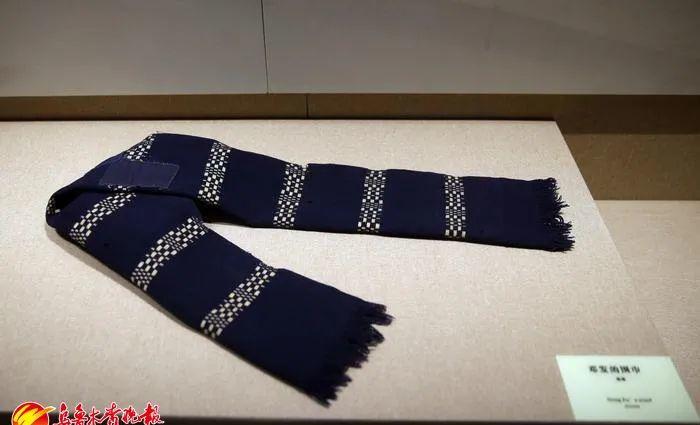Explore a stone tool on the shore of the Lake of Chaiwobao in the Paleolithic Era, admire a tiger-shaped gold artifact from the Warring States period, look up at the walls of the ancient city of Ulapo in the Tang Dynasty, and taste the poems written by Ji Xiaolan and Lin Zexu in the Qing Dynasty... With the opening of the Urumqi Museum (New Museum), Urumqi citizens have one more place to enjoy cultural life.
As of December this year, the Urumqi Museum (New Museum) has a collection of 16 national first-class cultural relics, 29 second-class cultural relics, and 102 third-class cultural relics, many of which have high cultural value, which can be called "the treasure of the town hall", let's go and see it together.

Deng Fa's scarf (national first-class cultural relics)
Deng Fa was one of the early leaders of the Communist Party of China and the early leader of the Chinese workers' movement. In September 1937, Deng Fa returned to China to Xinjiang and served as the representative of the Communist Party of China in Xinjiang and the director of the Xinjiang Office of the 18th Group Army, presiding over the Party's work in Xinjiang.
Jintang Yonggu Monument (general cultural relics)
Jintang Yonggu Monument was excavated in 1988 in the middle section of Hongqi Road in Urumqi. The texture is hard sandstone, with a residual height of 94 cm, a width of 94 cm and a thickness of 24 cm. The forehead of the square head is deeply embossed with double dragon play beads, and the lower part of the dragon melon is vertically engraved with the four characters of "Jintang Yonggu". The excavation of the stele is the location of the moat on the western wall of Dihua City (present-day Urumqi), which was built in 1763. The Jintang Yonggu Monument should be the foundation stone, which means that the city built is impregnable and indestructible.
Xinjiang Envoy Nomination Monument (National Second-Class Cultural Relics).
The original stele is embedded in the green brick wall of the lobby of the Xinjiang Cloth Envoy's Office, which was erected during the period when Wang Shufeng (nán) was appointed as the envoy (1906-1911). The stele is made of green sandstone with a round head, 155 cm high and 63 cm wide. The lower half of the stele is heavily eroded, the upper half is clearly written, and the inscription is 16 lines, which can be recognized nearly 300 words, recording the time and place of origin of the eight envoys from Wei Guangtao to Wang Shufeng.
Shares issued by Xinjiang Commercial Bank (national first-class cultural relics)
In February 1938, dispatched by the Party Central Committee, Mao Zemin assumed the pseudonym Zhou Bin, successively serving as the acting director of the Xinjiang Provincial Department of Finance and the acting director of the Department of Civil Affairs, and he carried out a drastic reform of Xinjiang's financial situation at that time, reversed the situation of economic chaos, made outstanding contributions to the development and construction of Xinjiang, and won the support of the people of all ethnic groups in Xinjiang.
Lin Ji Lu Family Letter (National First Class Cultural Relics)
In February 1938, Lin Jilu came to Xinjiang from Yan'an to do united front work, and served as the provost of Xinjiang College, the director of education of Aksu Special Region, the governor of Kuqa County, and the governor of Wushi County. During the War of Resistance Against Japanese Aggression, Xinjiang College had a special status, and communists and well-known progressive figures presided over the affairs of the academy, and put forward the educational ideology and proposition of "taking the nationality as the form and taking the Malian column as the content", which became an important position for the spread of Marxism-Leninism in Xinjiang, and its reputation spread far and wide, and it was known as "the second largest in the War of Resistance".
Provincial City Bricks (National Grade III Cultural Relics)
This is a brick when Urumqi was built, and it has the words "Provincial City Brick" on it. In May 1875, the Qing government appointed Zuo Zongtang, the governor of Shaanxi and Gansu, as the minister of Qincha to supervise the military affairs of Xinjiang, and in April 1876, Zuo Zongtang sat in Suzhou (present-day Jiuquan, Gansu) and ordered Liu Jintang and Jin Shun to lead two divisions out of the customs to eliminate the invading army of Agubai. In just over a year, the Xinjiang region except Ili was recovered. On November 17, 1884, the Qing government established a province in Xinjiang, named "Xinjiang" meaning "homeland new return", the provincial capital was set in today's Urumqi, and Urumqi was established as the political, economic and cultural center of Xinjiang.
Text Photo / Urumqi Evening News all-media reporter Wang Changtong Jiang Xiao
Video / Yu Zhuo Niu Huan Huan Gong Wanting